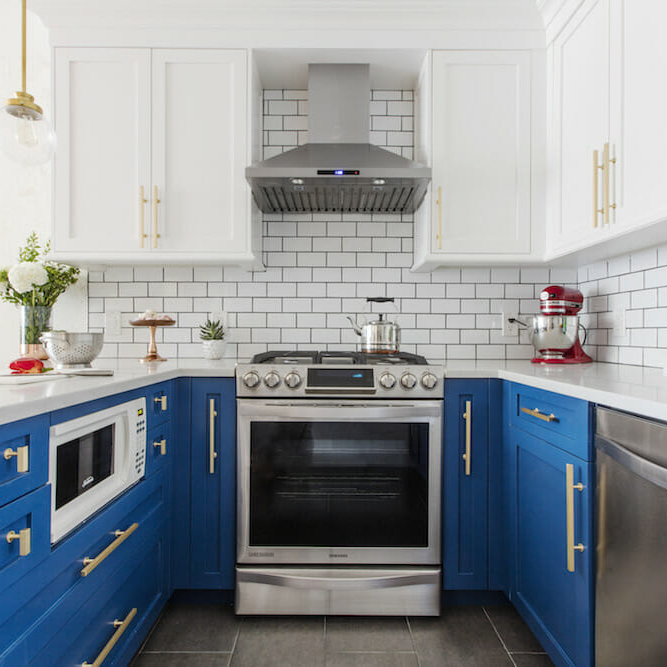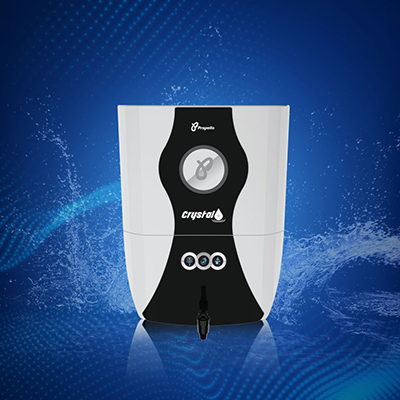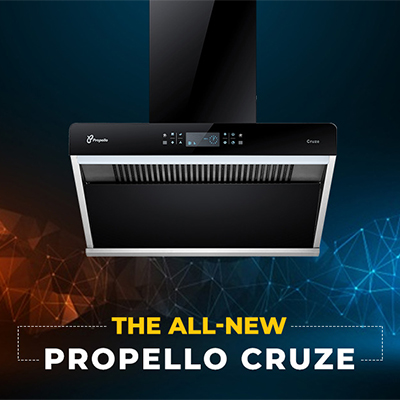
Easy Guide To Choose The Best Kitchen Chimney For Your New Home

An indispensable domestic appliance in any Indian kitchen is the chimney. The heavy use of oil and spices in Indian cooking results in a lot of smoke being emitted. Kitchen cabinets and tiles will become covered in thick, dark stains from the high smoke buildup if there isn’t a suitable exhaust system in place. However, since modular kitchens place a high value on interior design, one cannot take a chance on the kitchen’s aesthetics. Modular kitchen chimneys can help in situations like these.
Nowadays, the time and effort needed to make a dish that makes guests lick their fingers is about equal to what it takes to clean the dirt that has gathered on the kitchen fans and tiles. The smoke from grilling or frying can fill the entire house with an unpleasant smell. Is it less likely to get asthma and other respiratory issues if you have the greatest kitchen chimney? Feeling like you need to take a break from the situation and take a breather is normal. We’ve all experienced this horrible event at some point in our lives.
Regardless of the type of house you live in or the type of kitchen you have—modular or not—a chimney is necessary. particularly if preparing food is more labor than simply popping some bread into the toaster. Nowadays, a chimney is a must for all kitchen safety and hygienic requirements. First and foremost, kitchen chimneys maintain a grease-free, spotless kitchen.
With so many options, it could be challenging to select the chimney that will work best in your kitchen. The ideal option for small to medium-sized kitchens is usually a kitchen chimney of 60 centimeters. You can easily choose a larger size for chefs who have more space, depending on your needs and the size of your kitchen. Because of their sophisticated features and technology, kitchen chimneys for homes are more expensive than exhaust fans. They are still a wise investment for your kitchen, nevertheless, because they provide improved performance and air quality.
How can a kitchen chimney save you from health hazards?
Does having a chimney in your kitchen lessen the chance of developing asthma or other respiratory issues? The room’s stale, greasy air is expelled via the kitchen chimney. To capture the smoke and oil particles, a variety of filters are put inside the chimney. After then, the chimney allows the air to exit your house. Certain chimney designs even return the clean, fresh air to the cooking area.
Only the oily, stagnant air from your kitchen is intended to be removed by extracting chimneys. Filtered air is returned to the cooking area by the second chimney, which recycles air in a manner identical to the first. This construction is also known as a ductless chimney. Homes are equipped with chimneys such as this to protect occupants from the possibility of respiratory issues.
The irritable vapors released during cooking can be extinguished with a chimney. After consuming deep-fried meals, family members have trouble breathing and begin to sneeze. In addition to ensuring enough ventilation and removing excess heat from the kitchen, these measures also shield us against sneezing fits brought on by onions and red chilies, which may both suffocate us. All of the following will be avoided: dust, smoke, and overpowering smells. If you decide to utilize these goods, your family’s and your kids’ safety could be at danger.
Why is a chimney necessary in the kitchen?
- Smoke and Odors removal
Smoke and pungent smells are produced when cooking, particularly when high heat or specific ingredients are used. By effectively removing these emissions from the kitchen, a chimney helps to maintain clean, fresh air in the house and stops the fumes from spreading to other areas. In the kitchen, a chimney is essential since it plays a vital part in providing a secure and cozy cooking space. There are various significant reasons why a kitchen needs a chimney.
- Improving Indoor Air Quality
Improved indoor air quality is critical for the health and wellbeing of the inhabitants, and it is facilitated by effective smoke and odor removal. By reducing the amount of toxic cooking byproducts and allergens that are inhaled, a chimney can help.
- Preventing wall and Ceiling Stains
Without a chimney, grease and smoke can eventually collect on ceilings and walls, causing ugly stains. By keeping this from happening, a chimney lessens the need for regular upkeep and cleaning. Depending on how you cook, you might decide between an exhaust fan and the greatest kitchen chimney made by Faber.
- Reducing Residue Buildup
The accumulation of sticky residues on kitchen surfaces is lessened when a chimney is present, which facilitates easier and more manageable cleaning and maintenance. The suction force of kitchen chimneys is higher than that of exhaust fans. This is due to the fact that kitchen chimneys have strong motors and filters that have the capacity to draw out more air and contaminants from the kitchen.
- Heat and Grease Absorption
Grease and heat are other byproducts of cooking. In order to lower the danger of fire threats and maintain a cleaner kitchen, the chimney’s exhaust system helps to absorb and remove excess heat and grease from kitchen surfaces and cabinets.
How to select a chimney for your house?
Select a chimney based on your stove’s size. If you have a small gas stove with two burners, you should get a 60-centimeter chimney. In case your stove has three or more burners, it is recommended to select a 90 centimeter chimney. Generally speaking, to keep smoke from escaping, choose a chimney that is somewhat larger than the gas stove. Cubic meters per hour is the unit of measurement for a chimney’s suction capacity. You should select the suction capacity based on your preferred method of cooking and the size of your kitchen. A modest suction capability, for example, is appropriate for a small kitchen. If you often grill and deep-fry food, though—especially in commercial kitchens—you’ll need a chimney with a large suction capacity.
There are several forms and patterns for chimney hoods. When selecting the ideal chimney for your kitchen, take into account both the hood’s aesthetics and functionality. There are numerous designs of hoods, such as wall-mounted, island, and cabinet-insert models. The type of hood that works best for your kitchen will depend on its design. For example, if your kitchen gas burner is against the wall, then a wall-mounted chimney will be perfect. When making your selection, go for a kitchen chimney that is easy to use.
Touch panels and wave controllers are common on chimneys. Wave control technology allows you to effortlessly operate the gadget with a simple hand gesture. This is a really useful function when your hands are unclean. Chimneys with dry auto-clean technology are among the best options for Indian kitchens. The oil particles are collected separately for each oil collector thanks to the dry auto clean technology chimneys. A simple wash will suffice to clean the oil collector. Purchasing a chimney that fits your kitchen properly should be your top priority when planning to upgrade.
MORE USEFUL CHIMNEY SAFETY TIPS
- USE FIREWOOD SEASONED FOR AT LEAST 6 MONTHS
Compared to other types, well-seasoned firewood emits less pops and sparks and produces more heat. Even better is wood that has been treated for longer than six months, if you can find it. Please take additional care to protect your chimney by not burning any pressure-treated lumber or resinous trees, such as Christmas trees.
- Don’t use any kind of fire starters
Avoid lighting a fire with chemicals or liquids like motor oil, gasoline, etc. to maintain the highest level of chimney safety. Certain fuel starting kinds may leave behind dangerous residues that could spark a chimney fire. Use only those wood stove and fireplace starters made exclusively for these appliances.
- GET A NEW CHIMNEY CAP INSTALLED
For the safety of your chimney, new caps are always a smart idea. They prevent precipitation and animals that could impede the flow of flue gasses. The best chimney caps are made of stainless steel since they are resistant to weather and usually last longer. The newest dry auto-clean technology is installed in modern chimneys. Thus, there is no need for manual cleaning of these chimneys.
- SCHEDULE AN ANNUAL CHIMNEY SAFETY INSPECTION
Hiring fireplace experts is always the best option, even if you take certain preventative steps. Make an appointment for a yearly chimney safety inspection, and have the professionals check the water heater, flue, fireplace, and furnace to make sure there are no blockages inside or outside.
- KEEP YOUR FIREPLACE AREA CLEAR
In addition to ensuring that the chimney and fireplace are in good working order, chimney safety also entails keeping the area around the fireplace free. Furniture and other combustible items should be kept at least 48 inches away from the fireplace. In the presence of heat, flammable materials can quickly lose temperature and catch fire.
- CONSIDER THE USE OF ELECTRIC MODELS FOR MAXIMUM CHIMNEY SAFETY
Electric fireplaces are the best option if you want to avoid all the physical duties involved in maintaining the safety of your chimney. For people who are unable to install gas or wood fireplaces, these contemporary, reasonably priced fireplace styles are perfect. Furthermore, electric chimneys can be installed practically anywhere and still provide your living spaces with the ideal amount of warmth!
Why do you need a Kitchen Chimney?
A kitchen chimney is required when there is inadequate ventilation to remove smoke produced when cooking. This smoke is extremely damaging to our lungs and can lead to a number of illnesses, including allergies, bronchitis, and coughing, if inhaled over an extended period of time. For those with asthma or other heart conditions, it is extremely risky. We must maintain our indoor air pollution free because we already experience daily problems with pollution from the outside world. Chimneys also aid in that.
Typically positioned just over the gas stove, a kitchen chimney removes all smoke, smells, and oil, keeping the kitchen walls from becoming blackened by dirt and grease. Utilizing a kitchen chimney on a regular basis also helps to maintain a cool kitchen temperature.
Cooking is often a very demanding and monotonous task. You have to admit, even if you love to cook, that the combination of heat, smoke, steam, odor, oil, grease, and grime, as well as the (most horrifying) sweat, is not at all ideal. In addition, inhaling in cooking smoke poses health risks. In the past, installing an exhaust fan in the kitchen was the only true solution to this problem, which was considered a side effect of cooking.
However, as things have changed, more and more people are seeing the value of kitchen chimneys and how they can avoid all of the aforementioned issues. People are well aware of the risks to their health that arise from improper ventilation in kitchens and the critical function that kitchen chimneys play in these situations. The presence of a kitchen chimney in a contemporary kitchen has become increasingly essential.
What are the benefits of kitchen chimney?
kitchen chimney is essential. A common misconception among individuals is that since their kitchen exhaust fan is installed, they do not require a kitchen chimney. Cooking vapors and oil particles are extracted immediately upon release thanks to a kitchen chimney that is situated directly above the cooktop. Conversely, an exhaust fan is positioned at a distance from the cooktop and requires some time to remove smoke. Chimneys benefit greatly from this in comparison to exhaust fans. Fireplaces in kitchens are required for:
Better indoor air quality
Cooking for loved ones and friends is a fun activity for many individuals. Cooking does, however, release some heated gasses that are harmful to health. You can purge your kitchen air of harmful gases by using a chimney. It can help reduce the amount of carbon monoxide emitted when cooking.
Cleaner kitchen
The oil particles that are generated during cooking land on walls, cabinets, and tiles, giving them an ugly, oily appearance. Not all of the oil particles can be removed by an exhaust fan. Particles of grease and smoke can eventually cause damage to wood furniture, marble, granite, and tiles. The Propello kitchen chimney effectively removes smoke and oil particles, extending the duration of kitchen cleanliness and reducing the need for cleaning and upkeep.
Modern look
Your kitchen will be more aesthetically pleasing and useful when a chimney is installed. A chic chimney that complements your kitchen’s style might give it a more contemporary appearance. Choosing a kitchen chimney might be intimidating due to the abundance of options available. Among the top kitchen appliance brands is Propello.
Comfortable cooking experience
The fact that a kitchen chimney adds to the enjoyment of cooking is one of its main advantages. When using cooking utensils, it eliminates the heat and steam. They can’t make you perspire or feel the heat because of this. It also stops coughing and sneezing by pulling attention away from the aroma of cooking.
Consider before choose Kitchen Chimney For Your New Home Based on Your Kitchen Design
You should take into account your cooking habits, the size, layout, and current ventilation system of your kitchen before choosing a modular kitchen chimney. You should purchase a larger, more effective chimney if you frequently use a lot of oils and spices when cooking. The chimney’s size isn’t necessarily important; what matters is how it fits into the overall kitchen area. The interior design, layout, and general structure all play a role in choosing the ideal kitchen chimney, so make sure it aligns with your goals and expectations.
Chimney shapes vary depending on where they are intended to be installed; some common designs are box-shaped, straight-line, angular, curved glass, pyramid, etc. Chimneys can be arranged as built-in, integrated, downdraft, island, wall, ceiling, or corner mounted, among other configurations. Every kitchen is different in these aspects. Depending on how your kitchen is designed, you can choose the ideal kitchen chimney for your requirements. Because to its straightforward form, straight-line chimneys are typically purchased.
Conclusion
An open window or door is insufficient to allow smoke to escape, in which case a kitchen chimney is essential. Extended amounts of time spent inhaling this smoke can cause health issues like allergies, bronchitis, and coughing. Individuals with heart issues and asthma are especially susceptible to the consequences of this. Because we constantly interact with pollution outside, we need to ensure that the air we breathe within is as pure as possible. Chimneys are quite helpful in this regard.
Kitchen chimneys are the hub of the kitchen; they keep everything else clean and in working order, including gas stoves, rotisserie ovens, microwaves, induction cooktops, sandwich makers, top freezers, standard depth refrigerators, french door refrigerators, stainless steel food processors, mixer grinders, bottom freezers, and so on. When it comes to eliminating smoke and aromas from the kitchen, chimneys work better than exhaust fans. While an exhaust fan just expels air from the kitchen, a kitchen chimney uses a strong suction engine to draw smoke and other pollutants out of the space.
- Chimneys (53)
- Kitchen Chimney (137)
- Modular Kitchen (14)
- Water Purifiers (100)
- Best Water Purifier Brands in India – Trusted & Tested: Propello April 17, 2025
- Shop the Best Kitchen Chimneys Online for Homes: Propello April 16, 2025
- Propello – Best Kitchen Chimney Auto Clean Options for Your Home April 15, 2025
- Best Kitchen Chimney in India for Modern Homes 2025 | Propello April 14, 2025
- Kitchen Chimney Deals in Kolkata: Clean & Efficient Propello April 12, 2025
- Best Water Purifier Brands in India – Trusted & Tested: Propello
- Shop the Best Kitchen Chimneys Online for Homes: Propello
- Propello – Best Kitchen Chimney Auto Clean Options for Your Home
- Best Kitchen Chimney in India for Modern Homes 2025 | Propello
- Kitchen Chimney Deals in Kolkata: Clean & Efficient Propello
- April 2025
- March 2025
- February 2025
- December 2024
- July 2024
- February 2024
- December 2023
- November 2023
- October 2023
- September 2023
- August 2023
- July 2023
- June 2023
- May 2023
- April 2023
- March 2023
- February 2023
- January 2023
- December 2022
- November 2022
- October 2022
- September 2022
- July 2022
- June 2022
- January 2022
- December 2021
- October 2021
- September 2021
- August 2021
- July 2021
- June 2021
- January 2021
- December 2020
- November 2020
- October 2020
- September 2020
- August 2020
- July 2020
- June 2020
- May 2020
- March 2020
- February 2020
- January 2020
- October 2019


